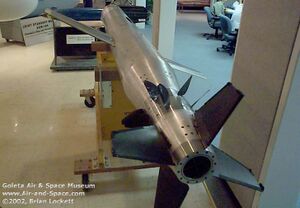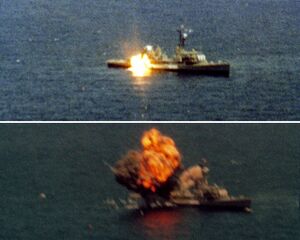GMaVa-36
| GMaVa-36 | |
|---|---|
 A proof of concept scale model of the GMaVa-36's propfan system | |
| Type | Cruise missile |
| Place of origin | |
| Service history | |
| In service | 1986 - present |
| Used by | |
| Production history | |
| Manufacturer | Trinovantanske Luftfartssystemer |
| Specifications | |
| Weight | 193 kg |
| Length | 6.42 m |
| Diameter | 520 mm |
| Warhead | 450 kg HE, Nuclear, or Bomblets |
| Engine | FEA Fo-300/44-3 Propfan |
| Wingspan | 3.55 m |
Operational range | 2000+ km |
| Flight altitude | ~50m AGL |
| Speed | 700 km/h |
Guidance system | GPS, INS, TERCOM |
Launch platform | Surface ships - Submarines - TELs |
The GMaVa-36 is a Trinovantan long-range ship-launched propfan cruise missile. It was developed to fly at very low altitudes over a long range, allowing Trinovantan Navy warships to strike at targets that were previously considered impervious to naval attack. In service to this role, the missile had numerous warhead packages developed for its use. Initially limited to launch from surface ships, land based and submarine launched variants were developed not long after the missile entered service. A specialized anti-shipping missile was also developed from the GMaVa-36, using a new guidance and sensor package as well as a semi-armor piercing warhead.
Design
The most immediately obvious feature of the GMaVa-36 is its engine. Originally designated as an “ultra-high bypass open rotor turbofan,” the FEA Fo-300/44-3 was one of the first of what are now commonly known as propfan engines to enter production. This type of engine was a derivative of turbofan designs intended to maximize the efficiency of the engine when traveling at mid/low subsonic speeds. Within that speed range, these engine types were approximately 30% more efficient than equivalent turbofan engines. Launching the missile is done via a small solid-fuel rocket booster, which rapidly accelerates the missile out of its container and up to an operational flight velocity.
The missile possesses four folding fins and a single large, rotating wing. The wing lacks any control surfaces and is used solely to generate lift. Flight control is handled solely by the fins near the rear of the missile. During the launch phase, the main wing rotates into flight position. After the launch booster is discarded, the control fins unfurl and the missile proceeds to navigate to its target.
Long range navigation is done via a GPS/INS system, with a TERCOM system being used to maintain a height of approximately 50 meters above ground level. The navigation systems of the missile have been subject to numerous major and minor updates since its initial development. These include but are not limited to a Digital Automatic Target Recognition system, a time-to-target control, data uplinks to allow the missile to be redirected to other targets after launch, and a new loitering flight profile.
The missile features a modular payload container, which allows for the missile to be quickly re-equipped with different warhead types as needed.
Munitions
Standard warhead options for the GMaVa-36 and its derivatives are:
- 450 kg of PBX explosive
- Submunition dispenser with 160 multipurpose bomblets
- Variable yield thermonuclear warhead with a 5-150 kt range
A number of special purpose warheads have been reportedly developed for the missile as well, including:
- Graphite dispenser for disabling power infrastructure
- Non-Nuclear ElectroMagnetic Pulse device for local disruption of electrical devices
- Aerosol dispenser for chemical or biological agents
- Combined-effects penetrator for destroying bunkers and other hardened targets
The GMaSø-36 anti-ship missile makes use of a specialized 450 kg semi-armor piercing warhead designed specifically to destroy ships.
Variants
- GMaVa-36 - Ship-launched variant, capable of launch via box or VLS.
- GUbVa-36 - Sub-launched variant with discardable launch capsule to protect the propfan engine, capable of launch via VLS or 533mm torpedo tube.
- GKjVa-36 - Ground-based truck launched variant.
- GMaSø-36 - Ship-launched anti-ship cruise missile with terminal active radar homing
Operational History
The first use of the GMaVa-36 missile was during the Omandan Continental War by Trinovantan battleship Karsten Askeladd not long after receiving the initial batch of production missiles. These missiles were used primarily to strike Transnapastaini logistical centers located deep inland. A total of 383 GMaVa-36 missiles were launched over the course of the Omand War, accounting for approximately 95% of missiles produced during this period.
Ostlichtor has alleged that Trinovantum caused the 1995 Hoffnung Blackout by firing GMaVa-36 missiles fitted with graphite bombs into the local power infrastructure. This blackout event directly interfered with Ostlichtor’s ability to coordinate its naval forces during the sinking of the Transnapastaini ship MV Utrennyaya Zvezda during the same time. Trinovantum has stated that no GMaVa-36 cruise missile variants were fired during this period and denies any responsibility for either event.

